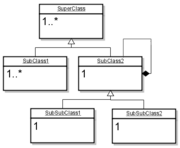Combining design patterns
(→Patterns Using Inheritance) |
(→Patterns Using Inheritance) |
||
| Line 12: | Line 12: | ||
=== Patterns Using Inheritance === | === Patterns Using Inheritance === | ||
| + | [[Image:InheritanceSingleton.png|right|thumb|The power of using a singleton in the inheritance hierachy]] | ||
| + | |||
* '''Superclass''' - Out of all of the subclasses there may only be one instance. | * '''Superclass''' - Out of all of the subclasses there may only be one instance. | ||
* '''Subclasses''' - Allows the inheritance hierarchy to have controlled constraints. See the attached image. | * '''Subclasses''' - Allows the inheritance hierarchy to have controlled constraints. See the attached image. | ||
Revision as of 01:09, 5 August 2009
Design patterns can be combined in numerous interesting ways to create super-patterns aka OO programs. A great example of this being done well is JUnit.
Contents |
Singleton + X
The singleton can be combined with a wide variety of patterns to create more specialised behaviour.
Proxy
By using a singleton on certain parts of a proxy a specific effect can be generated.
- Real Subject - Adding a singleton here means that any number of proxys can access this one class. This creates a specialised behaviour where different proxies can access a central object in different ways without being concerned that the right object is being called.
- Proxy - A singleton here makes sure that only a single proxy can be used to call any subject.
- Subject - A simple singleton here breaks the proxy pattern as no subclasses are allowed. A complex singleton, i.e. one that allows a controlled number of instances could be very powerful.
Facade
This is often a logical approach as it makes obtaining the correct object to access the complex system underneath straightforward.
Patterns Using Inheritance
- Superclass - Out of all of the subclasses there may only be one instance.
- Subclasses - Allows the inheritance hierarchy to have controlled constraints. See the attached image.
Note: the class vs object Encapsulation boundary becomes very important here.
| Design patterns | |
|---|---|
|
Creational: Abstract Factory | Builder | Factory Method | Prototype | Singleton | |
